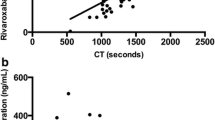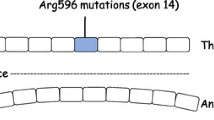Summary
-
1.
In patients under long-term anticoagulant therapy with coumarin derivatives, there is a good relationship between the results of Quick time and thromboplastin generation test, and between the results of Quick time and heparin tolerance test, under 30% of Quick value.
-
2.
Below 20–30% of Quick value, there is a true state of “intravascular” hypocoagulability by depressed “plasma thromboplastin” formation and heparin tolerance. This is in agreement with the clinical observation that the Quick value has to be below 20–30% for an efficient hypocoagulability.
Zusammenfassung
-
1.
Bei Patienten, welche unter Antikoagulantien-Langzeittherapie mit Cumarinderivaten stehen, besteht eine gute Beziehung zwischen den Ergebnissen der Quick-Zeit und dem Thromboplastin-Generations-Test und zwischen den Ergebnissen der Quick-Zeit und dem Heparin-Toleranz-Test, wenn sie einen Quick-Wert unter 30% haben.
-
2.
Bei einem Quick-Wert unter 20–30% findet sich eine tatsächliche intravasculäre Hypokoagulabilität durch erniedrigte Plasma-Thromboplastin-Bildung und Heparin-Toleranz. Dies stimmt mit der klinischen Beobachtung überein, daß der Quick-Wert zur Erzielung einer wirksamen Hypokoagulabilität unter 20–30% liegen muß.
Similar content being viewed by others
References
Biggs R. a. A. S. Douglas: J. Clin. Path.6, 23 (1953).
Douglas A. S.: Brit. Med. Bull.11, 39 (1955).
Duckert F., P. Flückiger, M. Mattera, F. Koller: Proc. Soc. Exp. Biol. Med. (N.Y.)90, 17 (1955).
Hicks N. D. e a. J. A. Bonnin: Brit. J. Haemat.5, 194 (1959).
Koller F.: Thromb. Diath. haem.2, 407 (1958).
In “Hemophilia and other hemorrhagic States”, International Symposium Rome 1958, p. 231. Edit. Univers. of North Carolina Press 1959.
Loeliger A. Thromb. Diath. haem.2, 441 (1958).
Miale J. B.: Laboratory Medicine-Hematology, p. 595. Edit. Mosby Comp., St. Louis, 1958.
Michaëlis J.: J. Biol. Chem.87, 33 (1930).
Sise H. S., D. M. Kimball a. D. Adamis: Proc. Soc. Exp. Biol. Med. (N.Y.)89, 81 (1955).
Soulier J. P. a. M. J. Larrieu: Les Anticoagulants en Thérapeutique, p. 27. Edit. G. Doin et Cie., Paris 1955.
Verstraete M., J. Vandenbroucke a. R. Holemans: Thrombosis and Embolism. Trans. lst International Conf. Basel 1954, p. 783. Benno Schwabe, Basel 1955.
von Kaulla K. N. a. W. Henkel: Klin. Wschr.31, 515 (1953).
Author information
Authors and Affiliations
Additional information
Supported by grant-in-aid of the Fonds de la Recherche Clinique Médicale.
Presently Fellow in Hematology, Tufts University School of Medicine, Boston, Mass.
Associée du Fonds National de la Recherche Scientifique.
Rights and permissions
About this article
Cite this article
Holemans, R., Verstraete, M. Influence of coumarin treatment on plasma thromboplastin formation and heparin tolerance. Blut 8, 29–34 (1962). https://doi.org/10.1007/BF01570369
Received:
Issue Date:
DOI: https://doi.org/10.1007/BF01570369




